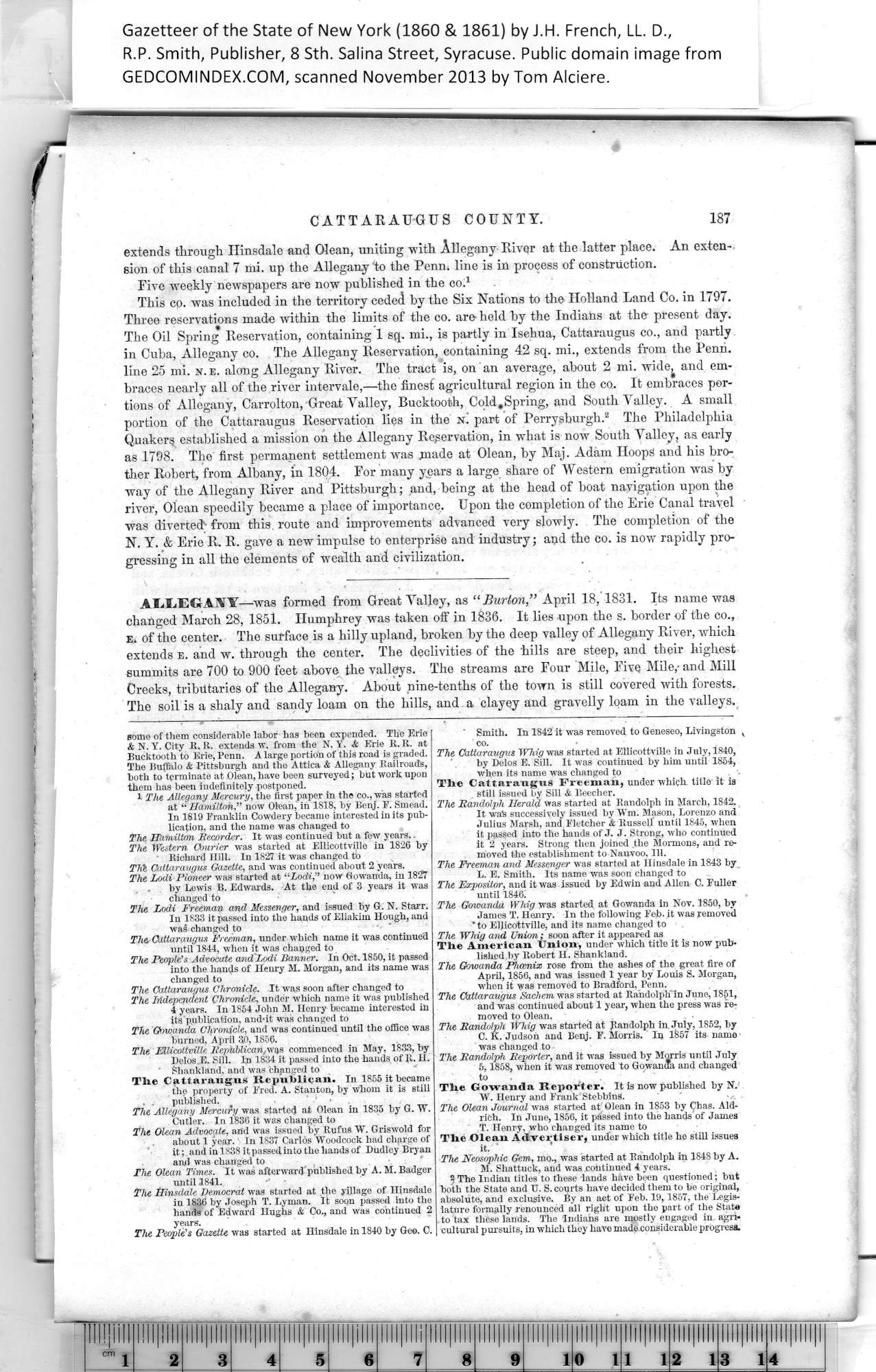|
some of them considerable labor has been expended. The Erie
& N. Y. City R, R. extends w. from the N. Y. & Erie R. R. at
Bucktooth to Erie, Penn. A large portion of this road is graded.
The Buffalo & Pittsburgh and the Attica & Allegany Railroads,
both to terminate at Olean, have been surveyed; but work upon
them has been indefinitely postponed.
1 The Allegany Mercury, the first paper in the co., was started
at “ Hamilton,” now Olean, in 1818, by Benj. F. Smead.
In 1819 Franklin Cowdery became interested in its pub¬
lication, and the name was changed to
The Hamilton Recorder. It was continued but a few years..
The Western Courier was started at Ellicottville in 1826 by
Richard Hill. In 1827 it was changed to
Th'e Cattaraugus Gazette, and was continued about 2 years.
The Lodi Pioneer was started at “Lodi,” now Gowanda, in 1827
by Lewis B. Edwards. At the end of 3 years it was
changed to
The Lodi Freeman and Messenger, and issued by G. N. Starr.
In 1833 it passed into the hands of Eliakim Hough, and
was changed to
The Cattaraugus Freeman, under which name it was continued
until 1844, when it was changed to
The People’s Advocate and Lodi Banner. In Oct. 1850, it passed
into the hands of Henry M. Morgan, and its name was
changed to
The Cattaraugus Chronicle. It was soon after changed to
The Independent Chronicle, under which name it was published
4 years. In 1854 John M. Henry became interested in
its publication, and-it was changed to
The Gowanda Chronicle, and was continued until the office was
burned, April 30,1856.
The Ellicottville Republican, was commenced in May, 1833, by
Delos.E. Sill. In 1834 it passed into the hands of 11. H.
Shankland, and was changed to *
The Cattaraugus Republic an. In 1855 it became
the property of Fred. A. Stanton, by whom it is still
. . published.
The Allegany Mercury was started at Olean in 1835 by G. TV.
Cutler. In 1836 it was changed to
The Olean Advocate, and was issued by Rufus W. Griswold for
about 1 year. In 1837 Carlos Woodcock had charge of
it; andinl838 itpassed into the hands of Dudley Bryan
and was changed to '
The Olean Times. It was afterward published by A. M. Badger
until 1841.
The Hinsdale Democrat was started at the yillage of Hinsdale
in 1836 by Joseph T. Lyman. It soon passed into the
hands of Edward Hughs & Co., and was continued 2
years.
The People’s Gazette was started at Hinsdale in 1840 by Geo. C. |
Smith. In 1S42 it was removed to Geneseo, Livingston v
co.
The Cattaraugus Whig was started at Ellicottville in July, 1840,
by Delos E. Sill. It was continued by him until 1854,
when its name was changed to
The Cattaraugus Freeman, under which title it is
still issued by Sill & Beecher.
The Randolph Herald was started at Randolph in March, 1842.
It was successively issued by Wm. Mason, Lorenzo and
Julius Marsh, and Fletcher & Russell until 1845, when
it passed into the hands of J. J. Strong, who continued
it 2 years. Strong then joined the Mormons, and re¬
moved the establishment to Nauvoo, 111.
The Freeman and Messenger was started at Hinsdale in 1843 by
L. E. Smith. Its name was soon changed to
The Expositor, and it was issued by Edwin and Allen C. Fuller
until 1846.
The Gowanda Whig was started at Gowanda in Nov. 1850, by
James T. Henry. In the following Feb. it was removed
*to Ellicottville, and its name changed to
The Whig and Union; soon after it appeared as
The American Union, under which title it is now pub¬
lished by Robert H. Shankland.
The Gowanda Phoenix rose from the ashes of the great fire of
April, 1856, and was issued 1 year by Louis S. Morgan,
when it was removed to Bradford, Penn.
The Cattaraugus Sachem was started at Randolph'in June, 1851,
and was continued about 1 year, when the press was re¬
moved to Olean.
The Randolph Whig was started at Pandolph in July, 1852, by
C. K. Judson and Benj. F. Morris. In 1857 its name
was changed to
The Randolph Reporter, and it was issued by Morris until July
5,1858, when it was removed to Gowanda and changed
to
The Gowanda Reporter. It is now published by N.
W. Henry and Frank Stebbins.
The Olean Journal was started at Olean in 1853 by Chas. Aid-
rich. In June, 1856, it passed into the hands of James
T. Henry, who changed its name to
The Olean Advertiser, under which title he still issues
it. ’
The Neosophic Gem, mo., was started at Randolph in 1848 by A.
M. Shattuck, and was continued 4 years.
2 The Indian titles to these lands have been questioned; but
both the State and U. S. courts have decided them to be original,
absolute, and exclusive. By an act of Feb. 19, 1857, the Legis¬
lature formally renounced all right upon the part of the State
to tax these lands. The Indians are mostly engaged in agri¬
cultural pursuits, in which they have made considerable progress. |
